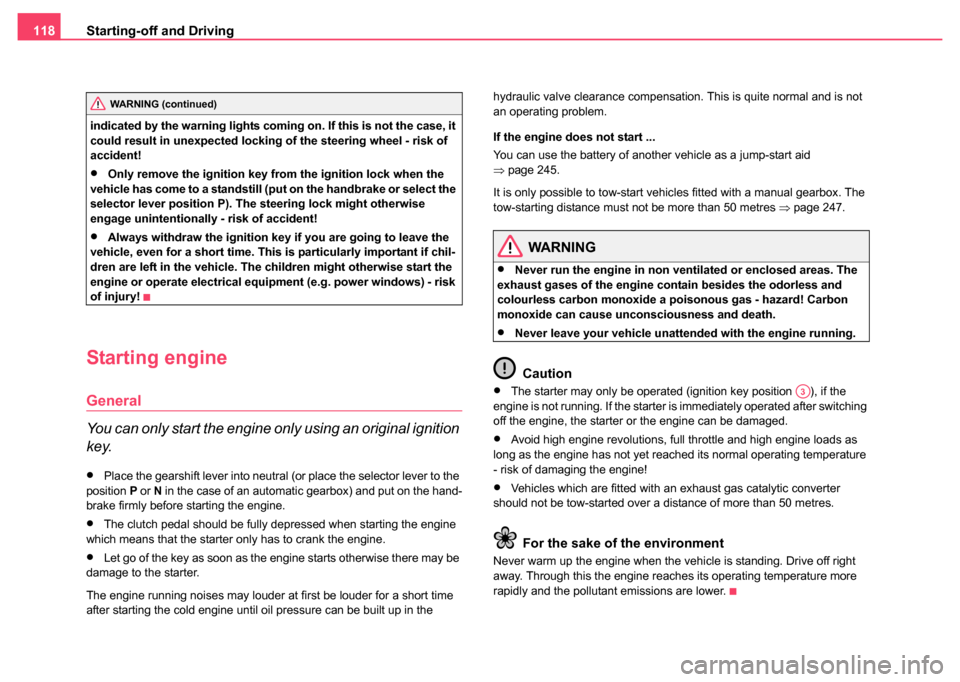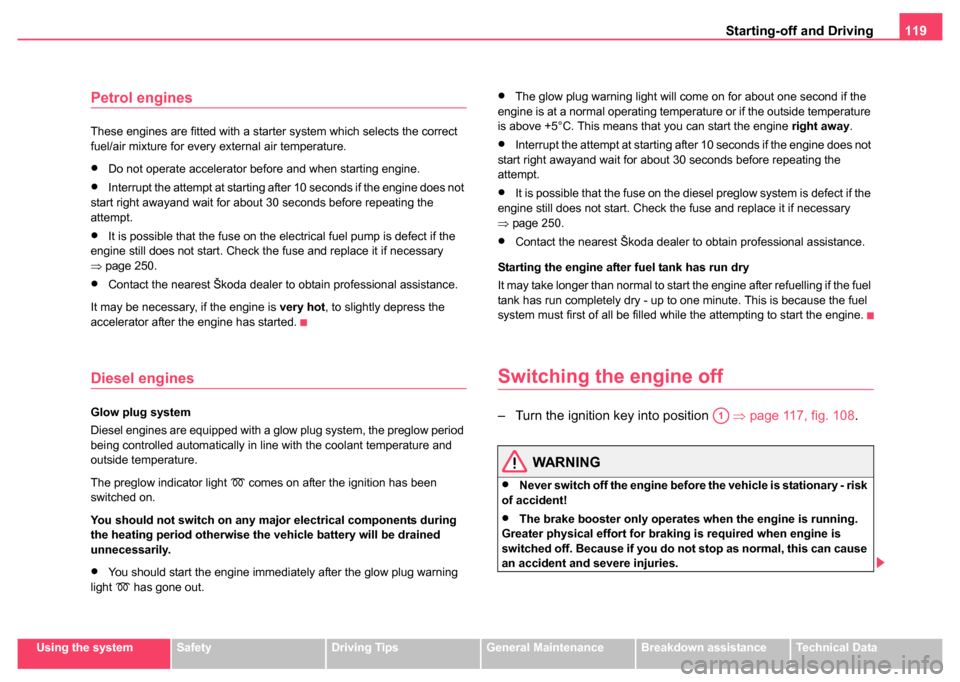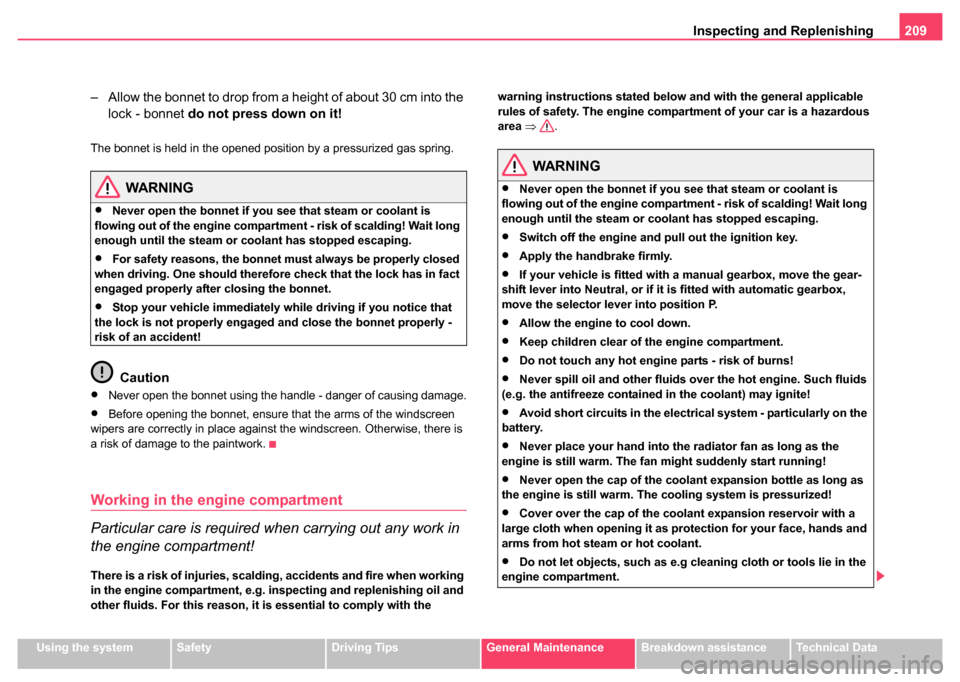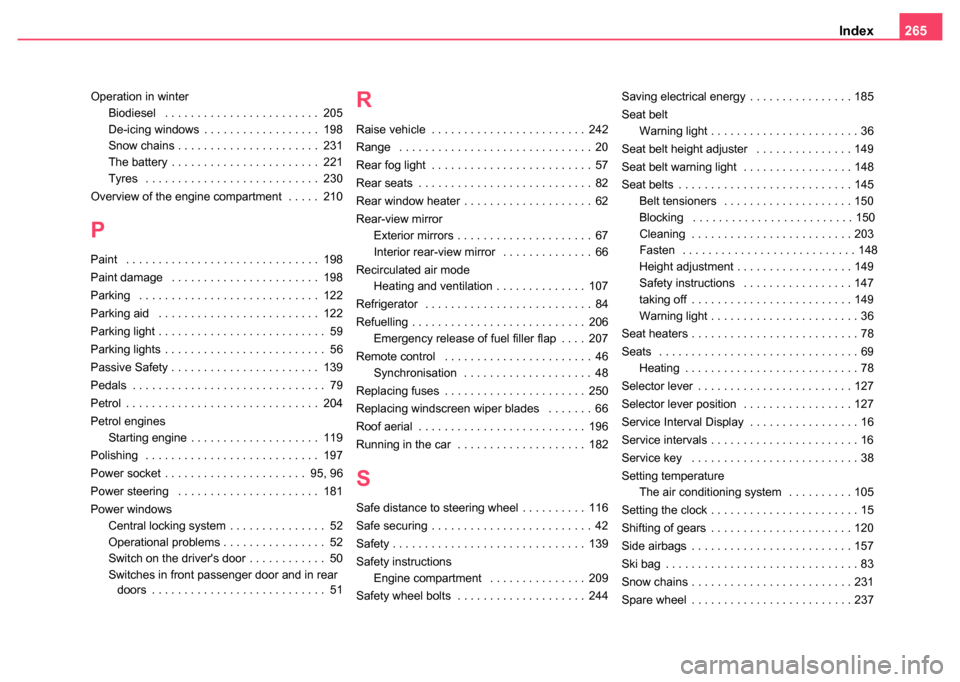key battery SKODA SUPERB 2004 1.G / (B5/3U) User Guide
[x] Cancel search | Manufacturer: SKODA, Model Year: 2004, Model line: SUPERB, Model: SKODA SUPERB 2004 1.G / (B5/3U)Pages: 270
Page 119 of 270

Starting-off and Driving
118
indicated by the warning lights coming on. If this is not the case, it
could result in unexpected locking of the steering wheel - risk of
accident!
•Only remove the ignition key fr om the ignition lock when the
vehicle has come to a standstill (put on the handbrake or select the
selector lever position P). The steering lock might otherwise
engage unintentionally - risk of accident!
•Always withdraw the ignition key if you are going to leave the
vehicle, even for a short time. This is particularly important if chil-
dren are left in the vehicle. The children might otherwise start the
engine or operate electrical equi pment (e.g. power windows) - risk
of injury!
Starting engine
General
You can only start the engine only using an original ignition
key.
•Place the gearshift lever into neutral (or place the selector lever to the
position P or N in the case of an automatic gearbox) and put on the hand-
brake firmly before starting the engine.
•The clutch pedal should be fully depressed when starting the engine
which means that the starter only has to crank the engine.
•Let go of the key as soon as the engine starts otherwise there may be
damage to the starter.
The engine running noises may louder at first be louder for a short time
after starting the cold engine until oil pressure can be built up in the hydraulic valve clearance compensation. This is quite normal and is not
an operating problem.
If the engine does not start ...
You can use the battery of another vehicle as a jump-start aid
⇒
page 245.
It is only possible to tow-start vehicles fitted with a manual gearbox. The
tow-starting distance must not be more than 50 metres ⇒page 247.
WARNING
•Never run the engine in non ventilated or enclosed areas. The
exhaust gases of the engine contain besides the odorless and
colourless carbon monoxide a poisonous gas - hazard! Carbon
monoxide can cause unconsciousness and death.
•Never leave your vehicle unattended with the engine running.
Caution
•The starter may only be operated (ignition key position ), if the
engine is not running. If the starter is immediately operated after switching
off the engine, the starter or the engine can be damaged.
•Avoid high engine revolutions, full throttle and high engine loads as
long as the engine has not yet reached its normal operating temperature
- risk of damaging the engine!
•Vehicles which are fitted with an exhaust gas catalytic converter
should not be tow-started over a distance of more than 50 metres.
For the sake of the environment
Never warm up the engine when the vehicle is standing. Drive off right
away. Through this the engine reaches its operating temperature more
rapidly and the pollutant emissions are lower.
WARNING (continued)
A3
Page 120 of 270

Starting-off and Driving119
Using the systemSafetyDriving TipsGeneral MaintenanceBreakdown assistanceTechnical Data
Petrol engines
These engines are fitted with a starter system which selects the correct
fuel/air mixture for every external air temperature.
•Do not operate accelerator before and when starting engine.
•Interrupt the attempt at starting after 10 seconds if the engine does not
start right awayand wait for about 30 seconds before repeating the
attempt.
•It is possible that the fuse on the electrical fuel pump is defect if the
engine still does not start. Check the fuse and replace it if necessary
⇒ page 250.
•Contact the nearest Škoda dealer to obtain professional assistance.
It may be necessary, if the engine is very hot, to slightly depress the
accelerator after the engine has started.
Diesel engines
Glow plug system
Diesel engines are equipped with a glow plug system, the preglow period
being controlled automatically in line with the coolant temperature and
outside temperature.
The preglow indicator light
comes on after the ignition has been
switched on.
You should not switch on any major electrical components during
the heating period otherwise the ve hicle battery will be drained
unnecessarily.
•You should start the engine immediately after the glow plug warning
light has gone out.
•The glow plug warning light will come on for about one second if the
engine is at a normal operating temperature or if the outside temperature
is above +5°C. This means that you can start the engine right away.
•Interrupt the attempt at starting after 10 seconds if the engine does not
start right awayand wait for about 30 seconds before repeating the
attempt.
•It is possible that the fuse on the diesel preglow system is defect if the
engine still does not start. Check the fuse and replace it if necessary
⇒ page 250.
•Contact the nearest Škoda dealer to obtain professional assistance.
Starting the engine after fuel tank has run dry
It may take longer than normal to start the engine after refuelling if the fuel
tank has run completely dry - up to one minute. This is because the fuel
system must first of all be filled while the attempting to start the engine.
Switching the engine off
– Turn the ignition key into position ⇒page 117, fig. 108 .
WARNING
•Never switch off the engine before the vehicle is stationary - risk
of accident!
•The brake booster only operates when the engine is running.
Greater physical effort for braking is required when engine is
switched off. Because if you do not stop as normal, this can cause
an accident and severe injuries.
A1
Page 137 of 270

Communicating and Navigating
136
Mobile phone, two-way radio system and
navigation system
Universal telephone connection at the front* (GSM II)
A telephone mount is factory-fitted. The mount is attached to the
centre console. Adapter (Cullmann) and mobile phone are not
factory-fitted by Škoda Auto.
Initialisation
– Withdraw the ignition key.
– First insert the adapter without the mobile phone into the
mount in the direction of arrow ⇒fig. 119 until the
adapter is touching the stop. Press the adapter slightly in the
direction of arrow until it locks into position. – Plug the adapter cable into the mobile phone socket. The
socket is located on the mobile phone mount below.
– Switch on the ignition.
– Wait approximately 20 seconds, switch off the ignition and pull the ignition key out of the ignition lock.
– Insert the mobile phone into the adapter (as specified in manufacturer's instructions) and switch on the ignition.
Removing the mobile phone and adapter
– Press the button and remove the mobile telephone.
An initialisation must be carried out:
•after the first connection of the adapter
•after reconnecting the battery
•after pulling out the adapter cable from the power socket for the mobile
phone
This enables you to make full use of the advantages of a normal carphone
(“handsfree system” using a microphone integrated in the vehicle, optimal
transmission of signals using an external aerial etc.). The battery of the
mobile phone is also constantly charged.
Please contact your Škoda dealer If there are any points which are not
clear.
Please also refer to the additional instructions ⇒page 138, “Mobile
phones and two-way radio systems” .Fig. 119 Universal tele-
phone connection at
the front
ABA1
A2
AA
AC
Page 138 of 270

Communicating and Navigating137
Using the systemSafetyDriving TipsGeneral MaintenanceBreakdown assistanceTechnical Data
Telephone pre-installation at the front or rear* (GSM
III)
Initialisation of the adapter
– Withdraw the ignition key.
– Insert the adapter into the mount (the mobile phone
must not be inserted in the adapter).
– Plug the adapter cable into the mobile phone socket.
– Switch on the ignition.
– Wait approximately 20 seconds, switch off the ignition and pull the ignition key out of the ignition lock.
– Insert the mobile phone into the adapter (as specified in manufacturer's instructions) and switch on the ignition.
An initialisation must be carried out:
•after the first connection of the adapter
•after reconnecting the battery
•after pulling out the adapter cable from the power socket for the mobile
phone
This enables you to make full use of the advantages of a normal carphone
(“handsfree system” using a microphone integrated in the vehicle, optimal
transmission of signals using an external aerial etc.). The battery of the
mobile phone is also constantly charged.
A telephone mount is factory-fitted for the front mobile phone and for the
rear mobile phone. The front telephone mount is located on the front
center console ⇒fig. 120 , the rear on the rear center console ⇒fig. 121 .
Adapter (Cullmann) and mobile phone are not factory-fitted by Škoda
Auto.
Please also refer to the additional instructions ⇒page 138, “Mobile
phones and two-way radio systems”.
Fig. 120 Universal
telephone connection
at the front
Fig. 121 Universal
telephone connection
at the rear
AAAB
Page 210 of 270

Inspecting and Replenishing209
Using the systemSafetyDriving TipsGeneral MaintenanceBreakdown assistanceTechnical Data
– Allow the bonnet to drop from a height of about 30 cm into the
lock - bonnet do not press down on it!
The bonnet is held in the opened position by a pressurized gas spring.
WARNING
•Never open the bonnet if you see that steam or coolant is
flowing out of the engine compartmen t - risk of scalding! Wait long
enough until the steam or coolant has stopped escaping.
•For safety reasons, the bonnet must always be properly closed
when driving. One should therefore check that the lock has in fact
engaged properly after closing the bonnet.
•Stop your vehicle immediately while driving if you notice that
the lock is not properly engaged and close the bonnet properly -
risk of an accident!
Caution
•Never open the bonnet using the handle - danger of causing damage.
•Before opening the bonnet, ensure that the arms of the windscreen
wipers are correctly in place against the windscreen. Otherwise, there is
a risk of damage to the paintwork.
Working in the en gine compartment
Particular care is required when carrying out any work in
the engine compartment!
There is a risk of injuries, scalding , accidents and fire when working
in the engine compartment, e.g. inspecting and replenishing oil and
other fluids. For this reason, it is essential to comply with the warning instructions stated below and with the general applicable
rules of safety. The engine compartment of your car is a hazardous
area
⇒ .
WARNING
•Never open the bonnet if you see that steam or coolant is
flowing out of the engine compartment - risk of scalding! Wait long
enough until the steam or coolant has stopped escaping.
•Switch off the engine and pull out the ignition key.
•Apply the handbrake firmly.
•If your vehicle is fitted with a manual gearbox, move the gear-
shift lever into Neutral, or if it is fitted with automatic gearbox,
move the selector lever into position P.
•Allow the engine to cool down.
•Keep children clear of the engine compartment.
•Do not touch any hot engine parts - risk of burns!
•Never spill oil and other fluids over the hot engine. Such fluids
(e.g. the antifreeze contained in the coolant) may ignite!
•Avoid short circuits in the electrical system - particularly on the
battery.
•Never place your hand into the radiator fan as long as the
engine is still warm. The fan might suddenly start running!
•Never open the cap of the coolant expansion bottle as long as
the engine is still warm. The cooling system is pressurized!
•Cover over the cap of the coolant expansion reservoir with a
large cloth when opening it as protection for your face, hands and
arms from hot steam or hot coolant.
•Do not let objects, such as e.g cleaning cloth or tools lie in the
engine compartment.
Page 223 of 270

Inspecting and Replenishing
222
WARNING
Never charge a battery which is frozen - risk of explosion!
Removing and installing the battery
Removing and installing the battery
– Please also refer to the notes when working on the battery
⇒page 218.
– Switched off all electrical components and remove the ignition key.
– Pull off gasket and take out the cover of the plenum chamber in the direction of the arrow ⇒fig. 166 .
– Unclamp the battery negative terminal (-).
– Unclamp the battery positive terminal (+).
– Unscrew the screw ⇒fig. 167 completely and remove the
locking plate.
– Move the battery in the direction of the arrow and pull it out in an upward direction.
Fig. 166 Engine
compartment: plenum
chamber - cover
Fig. 167 Engine
compartment: The
battery
AA
AB
AC
Page 266 of 270

Index265
Operation in winter
Biodiesel . . . . . . . . . . . . . . . . . . . . . . . . 205
De-icing windows . . . . . . . . . . . . . . . . . . 198
Snow chains . . . . . . . . . . . . . . . . . . . . . . 231
The battery . . . . . . . . . . . . . . . . . . . . . . . 221
Tyres . . . . . . . . . . . . . . . . . . . . . . . . . . . 230
Overview of the engine compartment . . . . . 210
P
Paint . . . . . . . . . . . . . . . . . . . . . . . . . . . . . . 198
Paint damage . . . . . . . . . . . . . . . . . . . . . . . 198
Parking . . . . . . . . . . . . . . . . . . . . . . . . . . . . 122
Parking aid . . . . . . . . . . . . . . . . . . . . . . . . . 122
Parking light . . . . . . . . . . . . . . . . . . . . . . . . . . 59
Parking lights . . . . . . . . . . . . . . . . . . . . . . . . . 56
Passive Safety . . . . . . . . . . . . . . . . . . . . . . . 139
Pedals . . . . . . . . . . . . . . . . . . . . . . . . . . . . . . 79
Petrol . . . . . . . . . . . . . . . . . . . . . . . . . . . . . . 204
Petrol engines Starting engine . . . . . . . . . . . . . . . . . . . . 119
Polishing . . . . . . . . . . . . . . . . . . . . . . . . . . . 197
Power socket . . . . . . . . . . . . . . . . . . . . . . 95, 96
Power steering . . . . . . . . . . . . . . . . . . . . . . 181
Power windows Central locking system . . . . . . . . . . . . . . . 52
Operational problems . . . . . . . . . . . . . . . . 52
Switch on the driver's door . . . . . . . . . . . . 50
Switches in front passenger door and in rear doors . . . . . . . . . . . . . . . . . . . . . . . . . . . 51
R
Raise vehicle . . . . . . . . . . . . . . . . . . . . . . . . 242
Range . . . . . . . . . . . . . . . . . . . . . . . . . . . . . . 20
Rear fog light . . . . . . . . . . . . . . . . . . . . . . . . . 57
Rear seats . . . . . . . . . . . . . . . . . . . . . . . . . . . 82
Rear window heater . . . . . . . . . . . . . . . . . . . . 62
Rear-view mirror
Exterior mirrors . . . . . . . . . . . . . . . . . . . . . 67
Interior rear-view mirror . . . . . . . . . . . . . . 66
Recirculated air mode Heating and ventilation . . . . . . . . . . . . . . 107
Refrigerator . . . . . . . . . . . . . . . . . . . . . . . . . . 84
Refuelling . . . . . . . . . . . . . . . . . . . . . . . . . . . 206 Emergency release of fuel filler flap . . . . 207
Remote control . . . . . . . . . . . . . . . . . . . . . . . 46 Synchronisation . . . . . . . . . . . . . . . . . . . . 48
Replacing fuses . . . . . . . . . . . . . . . . . . . . . . 250
Replacing windscreen wiper blades . . . . . . . 66
Roof aerial . . . . . . . . . . . . . . . . . . . . . . . . . . 196
Running in the car . . . . . . . . . . . . . . . . . . . . 182
S
Safe distance to steering wheel . . . . . . . . . . 116
Safe securing . . . . . . . . . . . . . . . . . . . . . . . . . 42
Safety . . . . . . . . . . . . . . . . . . . . . . . . . . . . . . 139
Safety instructions Engine compartment . . . . . . . . . . . . . . . 209
Safety wheel bolts . . . . . . . . . . . . . . . . . . . . 244 Saving electrical energy . . . . . . . . . . . . . . . . 185
Seat belt
Warning light . . . . . . . . . . . . . . . . . . . . . . . 36
Seat belt height adjuster . . . . . . . . . . . . . . . 149
Seat belt warning light . . . . . . . . . . . . . . . . . 148
Seat belts . . . . . . . . . . . . . . . . . . . . . . . . . . . 145 Belt tensioners . . . . . . . . . . . . . . . . . . . . 150
Blocking . . . . . . . . . . . . . . . . . . . . . . . . . 150
Cleaning . . . . . . . . . . . . . . . . . . . . . . . . . 203
Fasten . . . . . . . . . . . . . . . . . . . . . . . . . . . 148
Height adjustment . . . . . . . . . . . . . . . . . . 149
Safety instructions . . . . . . . . . . . . . . . . . 147
taking off . . . . . . . . . . . . . . . . . . . . . . . . . 149
Warning light . . . . . . . . . . . . . . . . . . . . . . . 36
Seat heaters . . . . . . . . . . . . . . . . . . . . . . . . . . 78
Seats . . . . . . . . . . . . . . . . . . . . . . . . . . . . . . . 69 Heating . . . . . . . . . . . . . . . . . . . . . . . . . . . 78
Selector lever . . . . . . . . . . . . . . . . . . . . . . . . 127
Selector lever position . . . . . . . . . . . . . . . . . 127
Service Interval Display . . . . . . . . . . . . . . . . . 16
Service intervals . . . . . . . . . . . . . . . . . . . . . . . 16
Service key . . . . . . . . . . . . . . . . . . . . . . . . . . 38
Setting temperature The air conditioning system . . . . . . . . . . 105
Setting the clock . . . . . . . . . . . . . . . . . . . . . . . 15
Shifting of gears . . . . . . . . . . . . . . . . . . . . . . 120
Side airbags . . . . . . . . . . . . . . . . . . . . . . . . . 157
Ski bag . . . . . . . . . . . . . . . . . . . . . . . . . . . . . . 83
Snow chains . . . . . . . . . . . . . . . . . . . . . . . . . 231
Spare wheel . . . . . . . . . . . . . . . . . . . . . . . . . 237